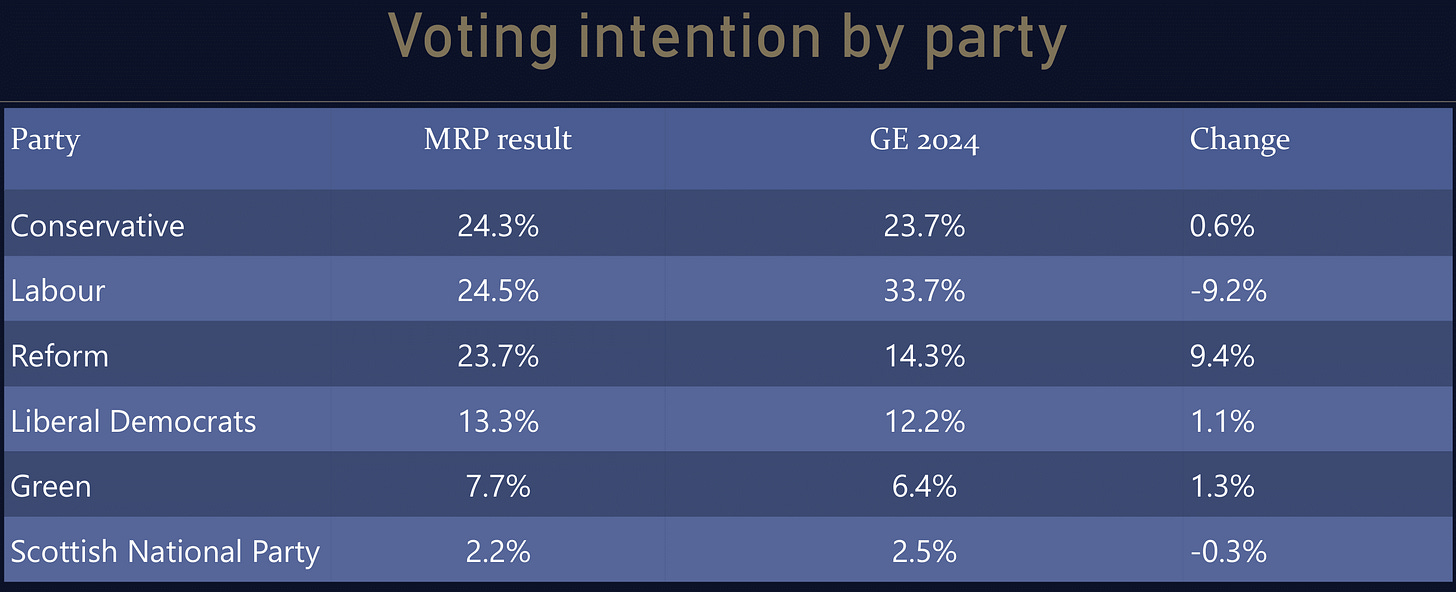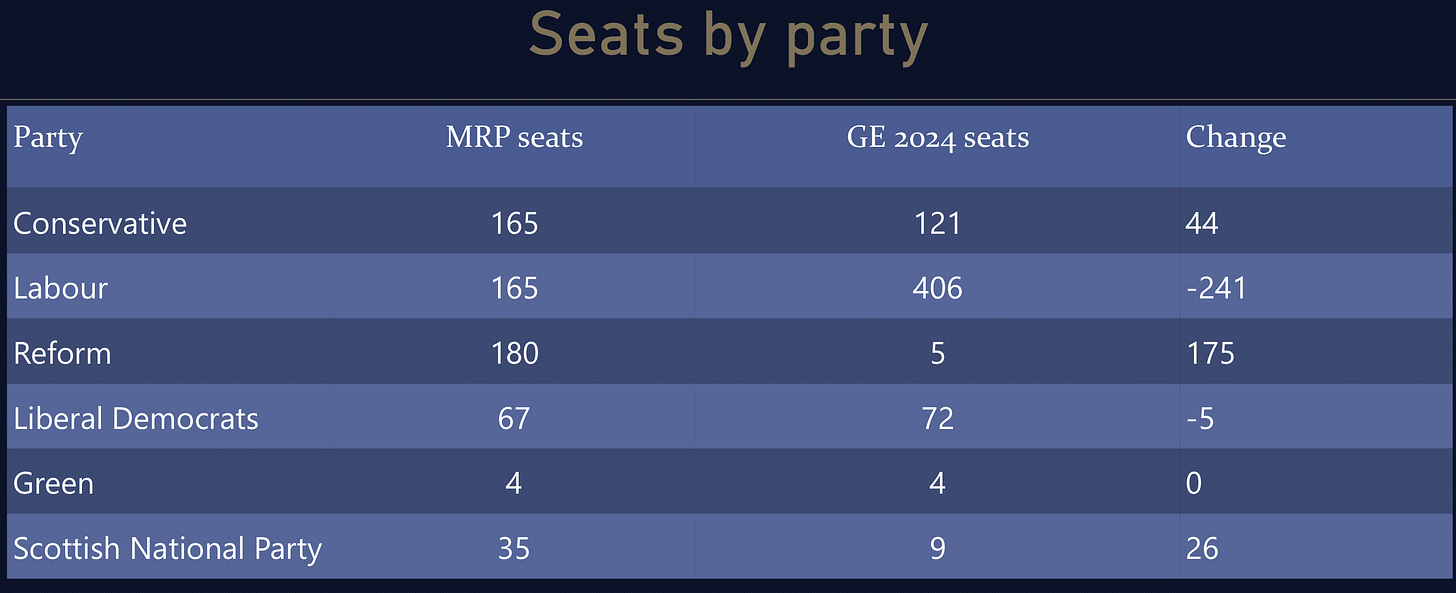Pollster: More in Common
Sample size: 16,176
Fieldwork dates: 14th March - 1st April 2025
Source
Key points
Reform would be the biggest party, with 180 seats, despite being the third-largest party by vote share.
Obvious geographic patterns would be confirmed: Reform taking semi-urban Northern, rural Midland, and coastal Eastern seats, as well as breaking through on the Welsh border.
Scottish independence would return with a vengeance as the unionist vote splits - perhaps irrevocably.
Despite taking only 23.7% of the national vote, Reform would, in theory, take 28% of the seats, while the Conservatives and Labour would take 24.3% and 24.5% each respectively, and have 25% of seats. First Past the Post, it must be remembered, is a locally determinative system - it is not based on an aggregate of the national vote - and so breakthrough parties usually focus on creating deep, concentrated pools of support rather than broad bases.
What would this parliament look like?
More in Common’s predictive map shows a vastly different parliament to what we have now, and indeed to what we have ever had. I recommend spending some time looking at the map and where the changes may take place, because this is the most detailed poll we’ve had so far and the most radically different.
There are three major take-aways from this poll that I think we should focus on: Labour’s collapsed majority and where the gains will be made, especially by ‘independents’; the concentration of Reform’s geographic support; and the role the Welsh and Scottish votes would play in such an outcome.
Collapse of Labour
Looking into the seat-by-seat prediction draws a picture of a Labour Party whose majority - exceptionally strong in Parliamentary terms, but unbelievably weak in terms of the popular vote - would utterly collapse. The Conservatives would end up retaking 62 seats from Labour, mostly in the heartlands of the Midlands and the South, though interestingly with some of the 2019 victories being regained. The Conservatives would also regain five seats from the Liberal Democrats, and lose none in the process. Overall, this would be a big success for the Tories, all things considered, and may position them strongly for a full return to power later down the line.
But the big story here is the almost total eradication of Labour in the North. Just look at that map; outside of the metropolitan areas of Leeds, Sheffield, Manchester and Liverpool, Labour is practically eradicated, and even then the cities are barely holding on. This is undeniably due to the historical pedigree Labour holds in such cities, but the fact that the “red wall” has been so utterly erased from parliamentary arithmetic is certainly something.
In the meantime, most of the losses are not to the Conservatives, a la 2019, but to Reform. For anyone perplexed by such a swing - buying into the old myth of the right-to-left spectrum - I really recommend reading three books: Revolt on the Right, by Rob Ford and Matt Goodwin (2014), which looks at the pipeline of historic Labour voters to disinterested to UKIP voters; The Road to Somewhere, by David Goodhart (2018), examining the attitudes of the public regarding markers of what we have come to call globalisation, such as mass immigration, globalised mega corporations, and the exclusion of non-degree educated from economic advancement; and finally, Cultural Backlash (2019) by Pippa Norris and Roger Inglehart, which moves past the material examinations of voters drifting to the “radical right” and considers the cultural motivations too. These three will, in my opinion, form the canon of studies of how Labour disappeared from the North, in years to come.
Finally, the collapse of Labour is aided by a particularly pernicious development in British politics: the emergence of more ‘independents’. By now a by-word for Islamist or sectarian-inspired activists, these independents would be projected to win in urban centres with pronounced inequality and notable Muslim populations:
Bethnal Green and Stepney
Birmingham Hall Green and Moseley
Bradford West
Ilford North
Slough
This naturally worries the Labour Party more than the Conservatives, as the Labour Party will now be eaten from two directions - the semi-urban ‘red wall’, and the deeply-urban ‘deprived’ city centres. Ilford North is, of course, held by Health Secretary Wes Streeting.
The turquoise crescent
While the red wall collapses, we will also witness the emergence of what I am calling the ‘turquoise crescent’, an unbroken curve of Reform seats starting in the Midlands and looping up over Leicester, through Doncaster into Lincolnshire and down through East Anglia. These are historically deeply conservative areas, and often returned UKIP MEPs in the days of Britain’s membership of the European Union, so this would simply be the confirmation of a trend that has long been growing.
Notably, under this MRP, Nigel Farage actually increases his vote share in Clacton to a whopping and unassailable 55%. At this point, Clacton definitely qualifies as a ‘safe seat’. Alongside this, not a single Reform seat would be lost, even and including Rupert Lowe’s seat of Great Yarmouth. Given Lowe’s undeclared future allegiance, whether this is a reflection of Lowe’s performance as a constituency MP or of the seat’s genuine Reform tendency is yet to be seen.
Moreover, as mentioned above, this poll would see Reform take 153 seats from Labour, but only 21 from the Conservatives. The idea that Reform is a ‘radical right’ party sapping votes from the Tories is far too simplistic for the actual picture that is emerging (or, has emerged, depending on your perspective), of a disaffected white Northern working class that hopes for a British national revival.
Wales and Scotland tell different stories
Finally, we must look at what this poll is telling us about the ‘Celtic fringe’. Usually, separatism trends upwards in both regions simultaneously, reflecting either a genuine desire for independence or dissatisfaction with Westminster. However, as the polling has consistently been showing for the last six months, Wales and Scotland have now fallen out of step with each other.
In Scotland, the Scottish National Party would resurge to almost their high water mark, with 35 predicted seats, of which 23 would be gained from Labour. In only one of those seats does SNP vote exceed the share of Labour plus Reform. Reform’s appearance in Scotland, while fairly low (at an average of 7% in most polls) and the resurgence of the Tories would undermine Labour’s majorities, allowing the SNP to come through the middle, despite actually taking fewer votes than in 2024.
This may well be the consequence of a slight buoyancy effect of Scottish Independence polling at 52%, the first time since January 2023. However, the fact that the SNP would only take a mild plurality of votes and seats should cast a sceptical light on such a prospect - if independence really was experiencing the level of support it supposedly is, surely the SNP would return to its historical dominance of Scottish politics.
In contrast however, Reform is project to take over half of all Welsh seats, along the border and clustered around Cardiff in the south. As I predicted nearly a year ago, this could well be because Plaid Cymru’s historic support in the Senedd, and Labour’s predominance in Westminster seats, is a protest against a culture of Westminster that privileges England, and Reform could be seen as an authentic ‘unionist’ voice. Alternatively, this could also be the latest and most successful protest vote, and Reform is simply offering the most virulent form of it. Only time will tell.
Thank you for reading this short Poll Watch post, in which I look at and discuss the most recent public opinion survey. Please consider subscribing to and sharing this blog and, if you’re feeling particularly generous, subscribing to my paid content -(detailed research and policy proposals).




